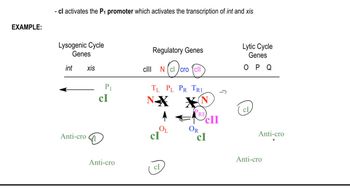Table of contents
- 1. Introduction to Genetics51m
- 2. Mendel's Laws of Inheritance3h 37m
- 3. Extensions to Mendelian Inheritance2h 41m
- 4. Genetic Mapping and Linkage2h 28m
- 5. Genetics of Bacteria and Viruses1h 21m
- 6. Chromosomal Variation1h 48m
- 7. DNA and Chromosome Structure56m
- 8. DNA Replication1h 10m
- 9. Mitosis and Meiosis1h 34m
- 10. Transcription1h 0m
- 11. Translation58m
- 12. Gene Regulation in Prokaryotes1h 19m
- 13. Gene Regulation in Eukaryotes44m
- 14. Genetic Control of Development44m
- 15. Genomes and Genomics1h 50m
- 16. Transposable Elements47m
- 17. Mutation, Repair, and Recombination1h 6m
- 18. Molecular Genetic Tools19m
- 19. Cancer Genetics29m
- 20. Quantitative Genetics1h 26m
- 21. Population Genetics50m
- 22. Evolutionary Genetics29m
12. Gene Regulation in Prokaryotes
Lambda Bacteriophage and Life Cycle Regulation
Problem 28b
Textbook Question
How would mutations that inactivate each of the following genes affect the determination of the lytic or lysogenic life cycle in mutated λ phage strains? Explain your answers. cII and cro
 Verified step by step guidance
Verified step by step guidance1
Understand the roles of cII and cro genes in the λ phage life cycle. The cII gene is crucial for the lysogenic cycle, while the cro gene is important for the lytic cycle.
Consider the effect of a mutation that inactivates the cII gene. Without cII, the phage is less likely to enter the lysogenic cycle because cII is responsible for activating the transcription of genes necessary for lysogeny.
Consider the effect of a mutation that inactivates the cro gene. Without cro, the phage is less likely to enter the lytic cycle because cro is responsible for repressing the transcription of genes necessary for lysogeny, thus promoting the lytic cycle.
Analyze how the inactivation of cII would lead to a preference for the lytic cycle, as the pathway to lysogeny is disrupted.
Analyze how the inactivation of cro would lead to a preference for the lysogenic cycle, as the repression of lysogenic genes is disrupted, allowing lysogeny to proceed.
Recommended similar problem, with video answer:
 Verified Solution
Verified SolutionThis video solution was recommended by our tutors as helpful for the problem above
Video duration:
3mPlay a video:
Was this helpful?
Key Concepts
Here are the essential concepts you must grasp in order to answer the question correctly.
Lytic and Lysogenic Cycles
The lytic and lysogenic cycles are two distinct pathways that bacteriophages, like λ phage, can follow after infecting a bacterial host. In the lytic cycle, the phage replicates rapidly, leading to the destruction of the host cell and the release of new phage particles. In contrast, the lysogenic cycle involves the integration of the phage DNA into the host genome, allowing it to replicate along with the host cell without causing immediate harm.
Recommended video:
Guided course

Decision Between Lytic and Lysogenic Cycles
cII Protein
The cII protein is a key regulatory protein in λ phage that promotes the lysogenic cycle. It stabilizes the expression of genes necessary for lysogeny, including the integration of phage DNA into the host genome. If mutations inactivate the cII gene, the phage is less likely to enter the lysogenic cycle, favoring the lytic cycle instead, which can lead to increased phage production and host cell lysis.
Recommended video:
Guided course

Proteins
cro Protein
The cro protein is another regulatory protein in λ phage that antagonizes the action of cII and promotes the lytic cycle. It represses the expression of genes required for lysogeny, thus favoring the production of new phage particles. Mutations that inactivate the cro gene would lead to reduced lytic activity and potentially allow for lysogenic development, as the balance between cII and cro is crucial for determining the phage's life cycle.
Recommended video:
Guided course

Proteins

 4:29m
4:29mWatch next
Master Bacteriophage Life Cycle with a bite sized video explanation from Kylia Goodner
Start learning


